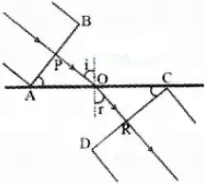1. According to Huygen’s principle
- Every point in a wavefront act as a source of secondary wavelets.
- The secondary wavelets travel with the same velocity as the original value.
- The envelope of all these secondary wavelets gives a new wavefront.
2. Huygen’s principle:
According to Huygen’s principle:
- Every point in a wavefront acts as a source of secondary wavelets.
- The secondary wavelets travel with the same velocity as the original value.
- The envelope of all these secondary wavelets gives a new wavefront.
Refraction of a plane wave. (To prove Snell’s law):
AB is the incident wavefront and c1 is the velocity of the wavefront in the first medium. CD is the refracted wavefront and c2 is the velocity of the wavefront in the second medium. AC is a plane separating the two media.

The time taken for the ray to travel from Pto R is

O is an arbitrary point. Hence AO is a variable. But the time to travel a wavefront from AB to CD is constant. In order to satisfy this condition, the term containing AO in eq. (2) should be zero.
∴ \(AO\Big(\frac{sin\,i}{C_1}-\frac{sin\,r}{C_2}\Big)\) = 0
\(\frac{sin\,i}{C_1}=\frac{sin\,r}{C_2}\)
\(\frac{sin\,i}{sin\,r}=\frac{C_1}{C_2}\) = 1n2(constant)
where 1n2 is the refractive index of the second medium w.r.t. the first. This is the law of refraction.
3. Light wave cannot be longitudinal as it exhibit polarisation.